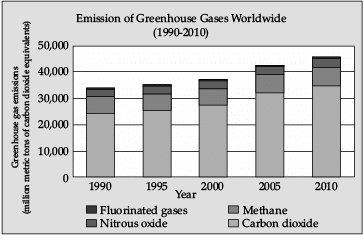Humanities/Arts Exam > Humanities/Arts Questions > Direction: Study the given graph on global g...
Start Learning for Free
Direction: Study the given graph on global greenhouse gas emission and answer any three of the following questions:

- a)Nitrous Methane
- b)Methane
- c)Fluorinated gases
- d)Carbon dioxide
Correct answer is option 'C'. Can you explain this answer?
Most Upvoted Answer
Direction: Study the given graph on global greenhouse gas emission an...
Fluorinated gases had the minimum emission in 1990.
Fluorinated gases (F-gases) are man-made gases that can stay in the atmosphere for centuries and contribute to a global greenhouse effect. F-gases are a subgroup of the halogenated gases, the majority of which are halocarbons that include fluorine, but do not include chlorine, bromine, or iodine.

|
Explore Courses for Humanities/Arts exam
|

|
Question Description
Direction: Study the given graph on global greenhouse gas emission and answer any three of the following questions:Q. Which gas had the minimum emission in 1990?a)Nitrous Methaneb)Methanec)Fluorinated gasesd)Carbon dioxideCorrect answer is option 'C'. Can you explain this answer? for Humanities/Arts 2025 is part of Humanities/Arts preparation. The Question and answers have been prepared according to the Humanities/Arts exam syllabus. Information about Direction: Study the given graph on global greenhouse gas emission and answer any three of the following questions:Q. Which gas had the minimum emission in 1990?a)Nitrous Methaneb)Methanec)Fluorinated gasesd)Carbon dioxideCorrect answer is option 'C'. Can you explain this answer? covers all topics & solutions for Humanities/Arts 2025 Exam. Find important definitions, questions, meanings, examples, exercises and tests below for Direction: Study the given graph on global greenhouse gas emission and answer any three of the following questions:Q. Which gas had the minimum emission in 1990?a)Nitrous Methaneb)Methanec)Fluorinated gasesd)Carbon dioxideCorrect answer is option 'C'. Can you explain this answer?.
Direction: Study the given graph on global greenhouse gas emission and answer any three of the following questions:Q. Which gas had the minimum emission in 1990?a)Nitrous Methaneb)Methanec)Fluorinated gasesd)Carbon dioxideCorrect answer is option 'C'. Can you explain this answer? for Humanities/Arts 2025 is part of Humanities/Arts preparation. The Question and answers have been prepared according to the Humanities/Arts exam syllabus. Information about Direction: Study the given graph on global greenhouse gas emission and answer any three of the following questions:Q. Which gas had the minimum emission in 1990?a)Nitrous Methaneb)Methanec)Fluorinated gasesd)Carbon dioxideCorrect answer is option 'C'. Can you explain this answer? covers all topics & solutions for Humanities/Arts 2025 Exam. Find important definitions, questions, meanings, examples, exercises and tests below for Direction: Study the given graph on global greenhouse gas emission and answer any three of the following questions:Q. Which gas had the minimum emission in 1990?a)Nitrous Methaneb)Methanec)Fluorinated gasesd)Carbon dioxideCorrect answer is option 'C'. Can you explain this answer?.
Solutions for Direction: Study the given graph on global greenhouse gas emission and answer any three of the following questions:Q. Which gas had the minimum emission in 1990?a)Nitrous Methaneb)Methanec)Fluorinated gasesd)Carbon dioxideCorrect answer is option 'C'. Can you explain this answer? in English & in Hindi are available as part of our courses for Humanities/Arts.
Download more important topics, notes, lectures and mock test series for Humanities/Arts Exam by signing up for free.
Here you can find the meaning of Direction: Study the given graph on global greenhouse gas emission and answer any three of the following questions:Q. Which gas had the minimum emission in 1990?a)Nitrous Methaneb)Methanec)Fluorinated gasesd)Carbon dioxideCorrect answer is option 'C'. Can you explain this answer? defined & explained in the simplest way possible. Besides giving the explanation of
Direction: Study the given graph on global greenhouse gas emission and answer any three of the following questions:Q. Which gas had the minimum emission in 1990?a)Nitrous Methaneb)Methanec)Fluorinated gasesd)Carbon dioxideCorrect answer is option 'C'. Can you explain this answer?, a detailed solution for Direction: Study the given graph on global greenhouse gas emission and answer any three of the following questions:Q. Which gas had the minimum emission in 1990?a)Nitrous Methaneb)Methanec)Fluorinated gasesd)Carbon dioxideCorrect answer is option 'C'. Can you explain this answer? has been provided alongside types of Direction: Study the given graph on global greenhouse gas emission and answer any three of the following questions:Q. Which gas had the minimum emission in 1990?a)Nitrous Methaneb)Methanec)Fluorinated gasesd)Carbon dioxideCorrect answer is option 'C'. Can you explain this answer? theory, EduRev gives you an
ample number of questions to practice Direction: Study the given graph on global greenhouse gas emission and answer any three of the following questions:Q. Which gas had the minimum emission in 1990?a)Nitrous Methaneb)Methanec)Fluorinated gasesd)Carbon dioxideCorrect answer is option 'C'. Can you explain this answer? tests, examples and also practice Humanities/Arts tests.

|
Explore Courses for Humanities/Arts exam
|

|
Signup for Free!
Signup to see your scores go up within 7 days! Learn & Practice with 1000+ FREE Notes, Videos & Tests.























